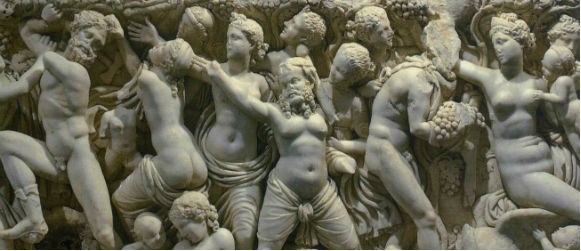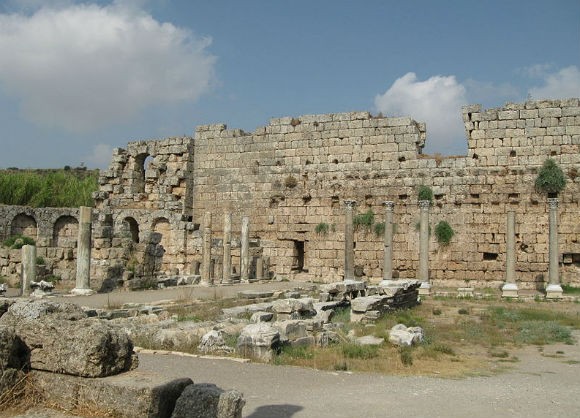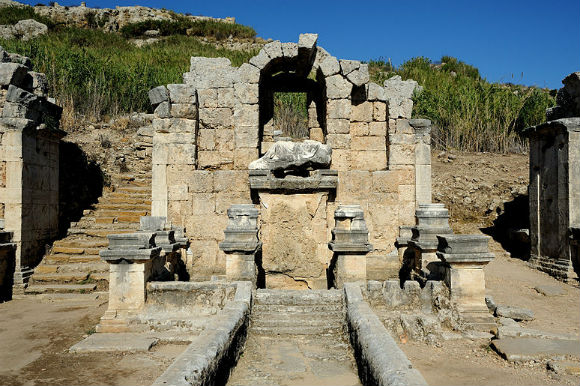Perga was an old city even in the first century. Its name (which is not Greek) indicates that its origin dates from pre-Greek times. Alexander the Great passed through it twice while the Pergaeans offered no resistance to him although it was a walled city with a citadel. In Roman times the main streets were over twenty-one meters wide. They were lined with Ionic colonnades and a water channel ran down their center in a series of small waterfalls as in Antalya today. Behind the colonnades stood the shops. Of the early buildings the stadium and the theater have survived the ravages of earthquakes and wars with the least damage. In fact this stadium which could seat about fourteen thousand people is one of the best preserved in Turkey.
The temple of the Pergaean Artemis according to a writer of the time was “a marvel of size, beauty, and workmanship.” Its location has yet to be established; it may have been where there are now ruins of a Byzantine church on a hill to the southeast of the city.
Perga is on a rise not far from the Cestrus River which was navigable In Paul’s time. It was not a seaport in terms of Its being directly on the Mediterranean even then, but rather it was more easily defended where it was: its distance from the open sea made it less vulnerable to piracy.
Two people stand out among the early residents of Perga. Apollonius was a third century B.C. astronomer and mathematician who believed that the movements of heavenly bodies in the universe were explainable by orbits within orbits: that the moon went around the earth as the earth went around the sun. He was much ahead of his time in his theories of astronomy, so much so that the ideas had to be rediscovered during the Renaissance. Plancia Magna was unusual for a second century A.D. woman: she held the highest city office during her life, that of demiurgus. She must have been well-to-do for a number of inscriptions record her gifts to the city.
Paul and Barnabas went through Perga on their way to and from Antioch on their first journey (Acts 13:13, 14:25). John Mark was with them at first but left them at Perga to return to Jerusalem. The reason for that must have been such that Paul doubted his commitment to the cause. Later when Paul and Barnabas were about to start on their second journey from Antioch they had a sharp dispute over his worthiness. Paul refused to have him go along, so John and Barnabas went to Cyprus while Paul chose Silas to accompany him.
Paul talks in II Corinthians 12:7 and in Galatians 4:13-14 of bodily illness that brought him to Galatia the first time. It may have been on that account that he did not stay long in Perga the first time. Whatever the illness was, it seems to have improved in time in the dry mountain air to the north.
The second theory of why they did not stay long in Perga is that their interview with Sergius Paulus, the proconsul of Cyprus, had made them want to hurry to the Roman colony in Antioch of Pisidia. This interpretation may lay too much stress on the lasting importance of that meeting with a cultured Roman who could have been more interested in the pursuits of the mind than the salvation, in Christian terms, of his soul. It is interesting, however, that this is” the point in Acts (13:9) that Luke begins to call Paul by his Roman name, not his Jewish “Saul”.
On their return they did stay in Perga long enough to preach and talk with people there. Nothing else is told about the city or their time there.
Perga,






Most impressive of all the historical sites around Antalya. Very close to the city (app 30 min drive). Well preserved and great for those who know the Bible and want to follow Paul's steps. Paul gave two sermons in Perge.
Perge we liked much more compared to Aspendos.
Both sites we visited in the same day. We took a taxi from Antalya (in total we paid 40 euro after handling the price. Original prices: 65 euro for Aspendos and 35 euro for Perge. probably you can get a better price)
Entrance ticket for Perge is 15 Tl (they do not…
seen it all b4 not explained enough by staff
walk round site guide could not hold guests together most guests seen it all b4
If you have little time, choose to visit Aspendos rather than Pergé. However, Pergé is interesting as well. Note that the theater in Pergé cannot be visited as it threatens to collapse, which is a bit frustrating.
We arrived just a few minutes after opening time, and were already beaten by numerous tour buses! The site is very large and extends along the road as you get to the entrance to the site; not really any opportunities for parking along the road to take pictures, unfortunately. Perge is an active archeological excavation, and there are areas out…
The area of these ruins is vast. You can walk around for quite some time but it's best to have a guide explain some of the history, unless you prefer to be independent.
There is the remains of a ancient stadium and aqueduct further away.
The city is great and I will let other reviewers address this. I am simply updating mass transit instructions for people who want to save a bit of money.
From Kaleici (old town Antalya) you can catch the new tram (Antray) to the Meydan stop. It cost me 2TL each way.
At the Meydan stop you will see a bus…
We went on an organised trip made by our hotel rep. We really enjoyed it and was very happy that the tour guide took us early as it was 44 degrees and not a lot of shady areas.
Some parts of the site are still being excavated, it is very impressive to see.
We visited the ruins of this city as part of our tour. We had a very good tour guide who spent more than an hour walking us through the ruins showing us where all the baths, shops, gates, waterways, etc were. It is certainly well worth spending time and having a good guide.
beautiful site, small, quiet. good for a one hour stay. ugly threads
from electricity disturb the view, unfortunally